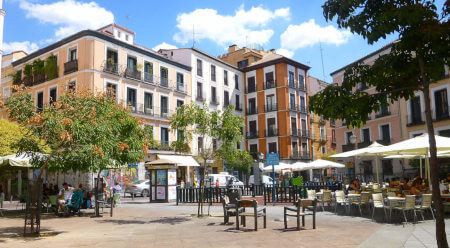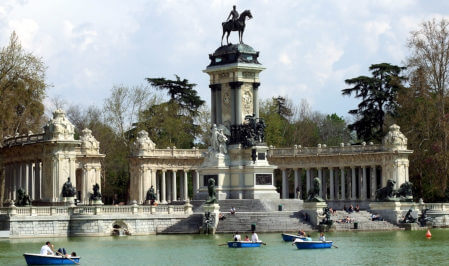Not even the natives of Madrid are often able to define their city. Madrid is many things at once. One thing that always surprises foreigners is that when two Madrid citizens meet and one asks the other where they come from, they always name their neighborhood. Madrid encloses many worlds, sometimes only delimited by one street. Each district of Madrid offers a different vision of the city. From the southern working-class neighborhoods to the northern residential neighborhoods, each one has a story to tell.
For students doing a Spanish course in Madrid, getting to know Madrid’s neighborhoods is a wonderful way to enjoy Madrid to the fullest, to get to know every corner, every shop, every accent and every way of seeing the world.
Some of the most historic and interesting neighborhoods to see in Madrid are the Lavapiés neighborhood, which has become today a melting pot of cultures and nationalities.
Others, such as the Malasaña and La Latina neighborhoods, are the reason Madrid is called the city that never sleeps, with hundreds of bars and pubs where visitors and locals mix to enjoy Madrid’s liveliest atmosphere.
If we move to the Salamanca neighborhood we find the world of luxury, the most prestigious fashion brands and the high bourgeoisie, and if we move to the transgressor Chueca neighborhood we find the area that has become an international reference point for the LGTBIQ movement and tightly linked to the Gay Pride festivities, which are held every year in June and attract thousands of visitors.
To get to know the most classical Madrid, that of kings, nobles and knights, we must go to the “Madrid de los Austrias” (Habsburg Madrid) and the “Madrid de los Borbones” (Bourbons Madrid), mandatory to visit. The “Madrid de los Austrias” is the name given to the Madrid of the time when the Habsburg dynasty reigned and has such emblematic and picturesque places as the Plaza Mayor, the Plaza de la Paja, the Plaza de la Villa, the Calle Mayor … The walk also passes through the Plaza de Ópera, the Teatro Real in Madrid (Royal theater), the Palacio Real (Royal Palace), the Catedral de la Almudena (Almudena Cathedral) the San Miguel Market and the famous Puerta del Sol, where the people of Madrid continue the tradition of eating 12 grapes every 31st of December to welcome the new year.
The “Madrid de los Borbones” traces just the other half of the city and refers to this dynasty, especially Charles III, known as the “best mayor of Madrid”.
The walk through this area starts at Puerta del Sol and goes down through Calle Alcalá to the famous Puerta de Alcalá, the Retiro park and the fountains (Cibeles and Neptuno) where football fans from Madrid celebrate all their victories.
As if all this were not enough, Madrid has also been the cradle and inspiration for the greatest writers of Spanish literature, as well as filmmakers, actors and an infinite number of artists who stand out on the international scene. To wander through the streets of Madrid is to get closer to the trajectory of these artists.
Getting to know Madrid is, without a doubt, getting to know its neighborhoods, one more reason to come to Madrid and study Spanish in Madrid in the summer.
“Do you want to learn Spanish in Madrid and get to know its neighborhoods?” “Get closer to the most traditional culture of Madrid”
















